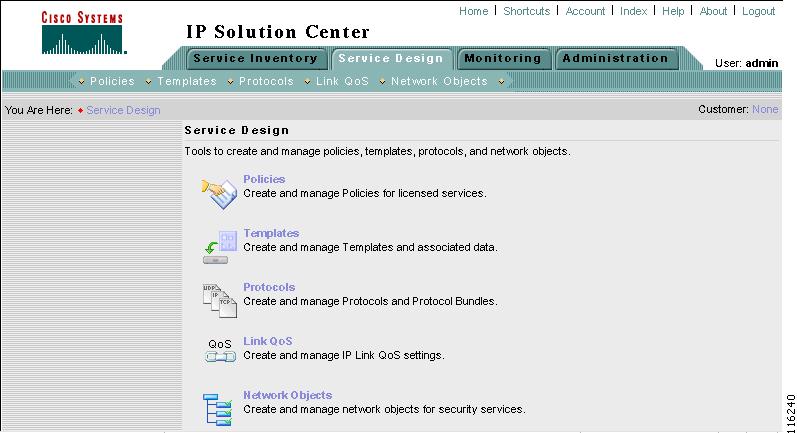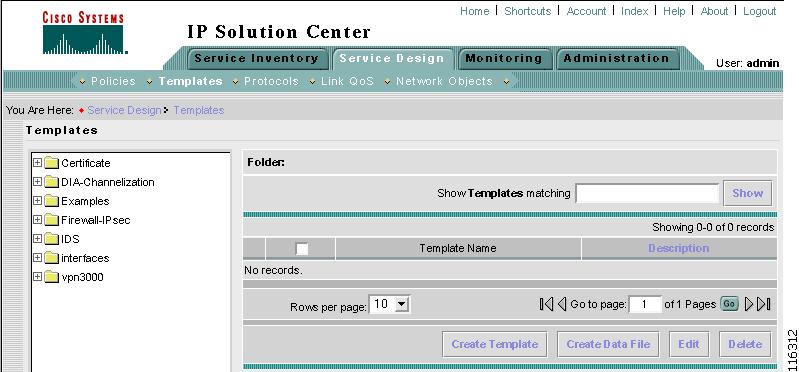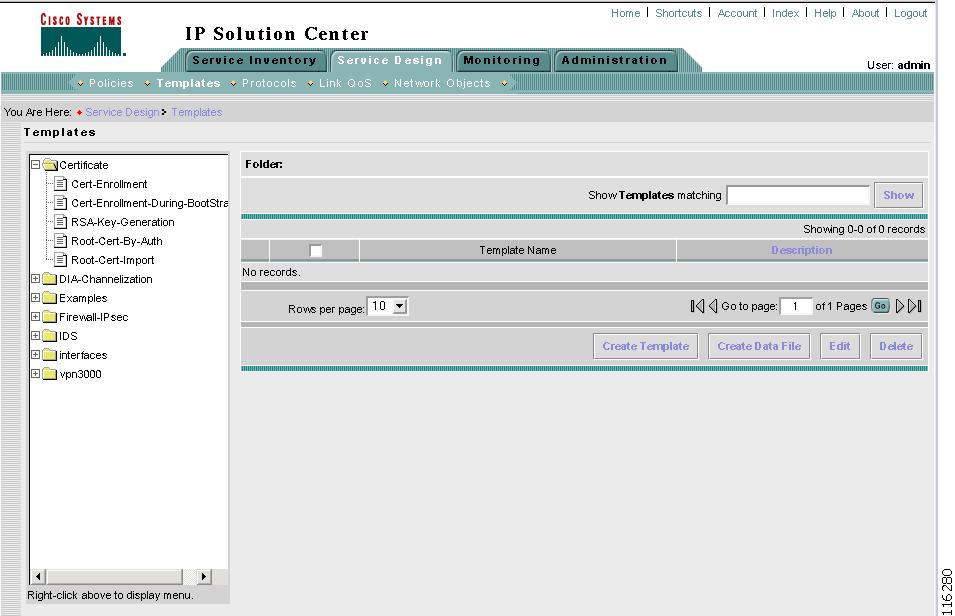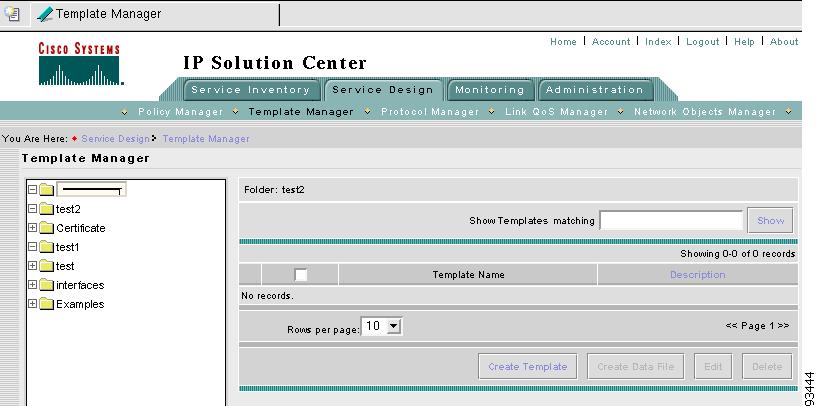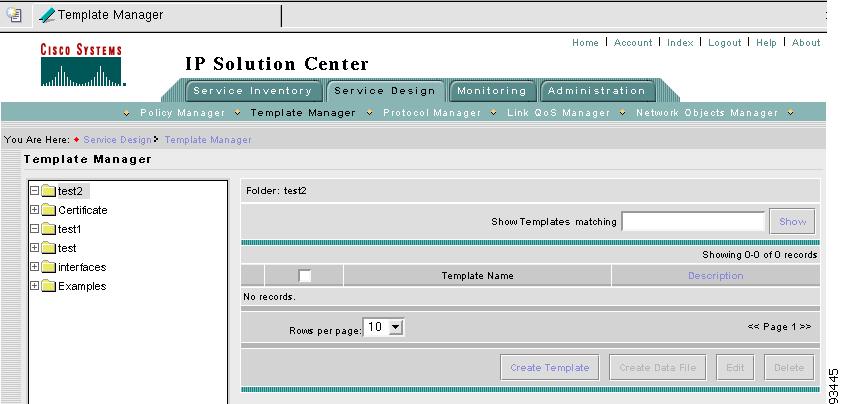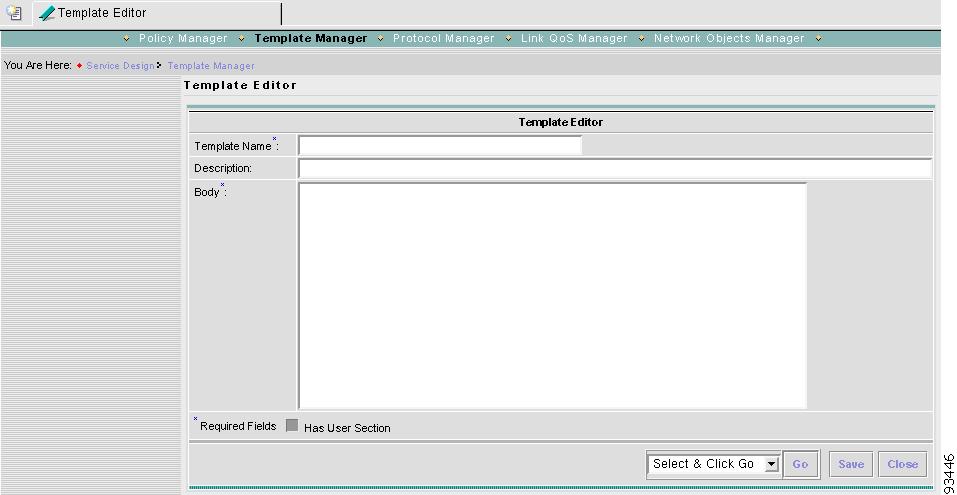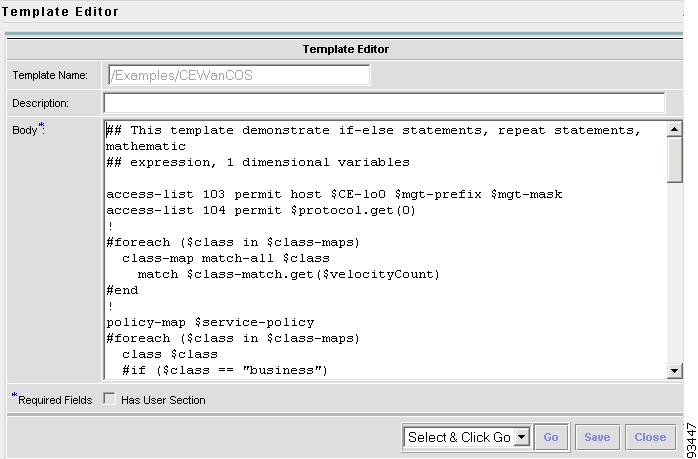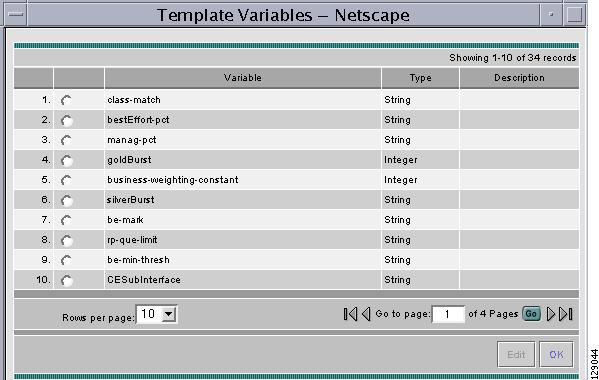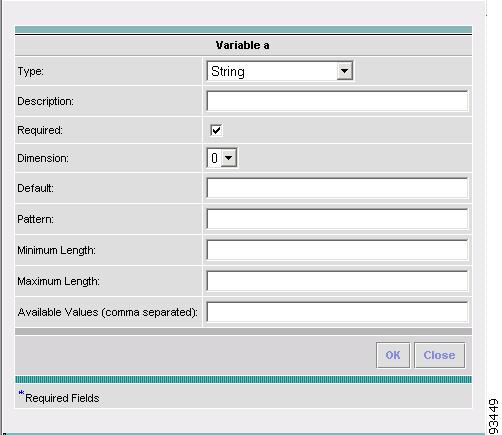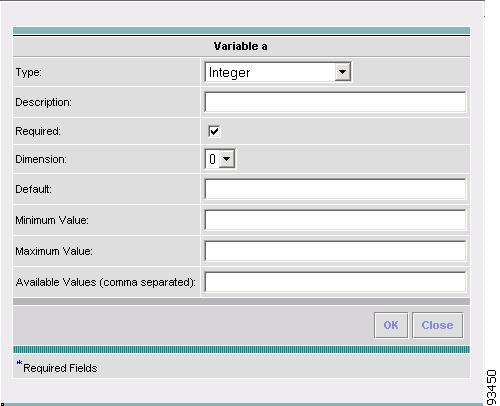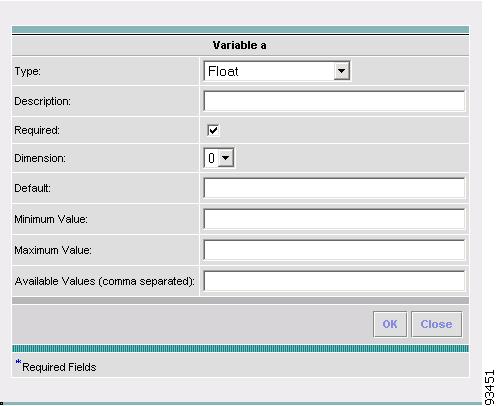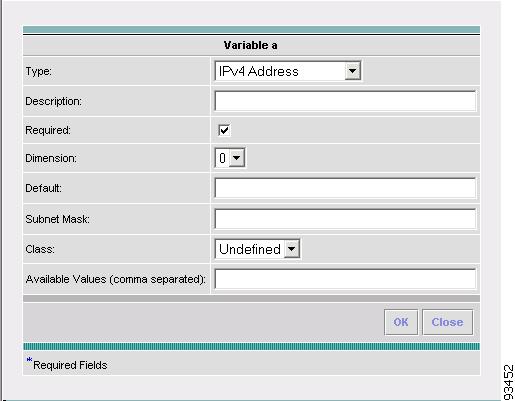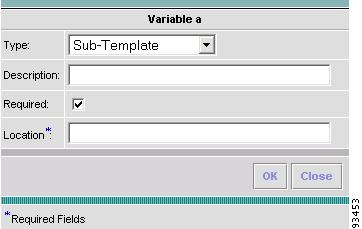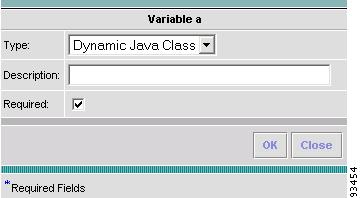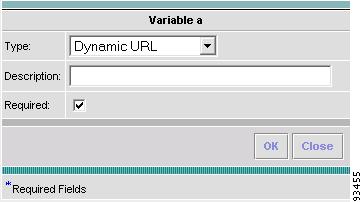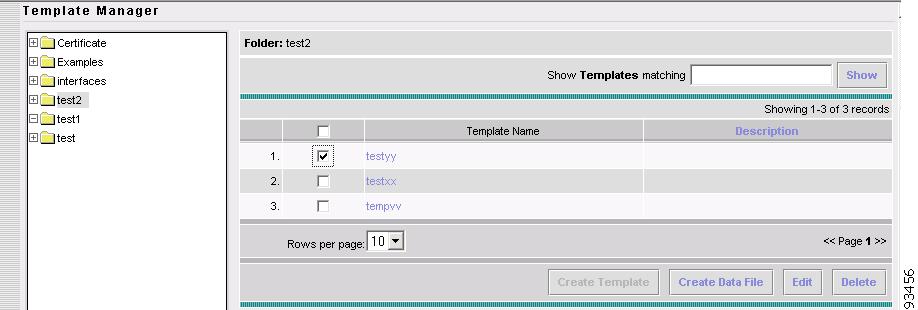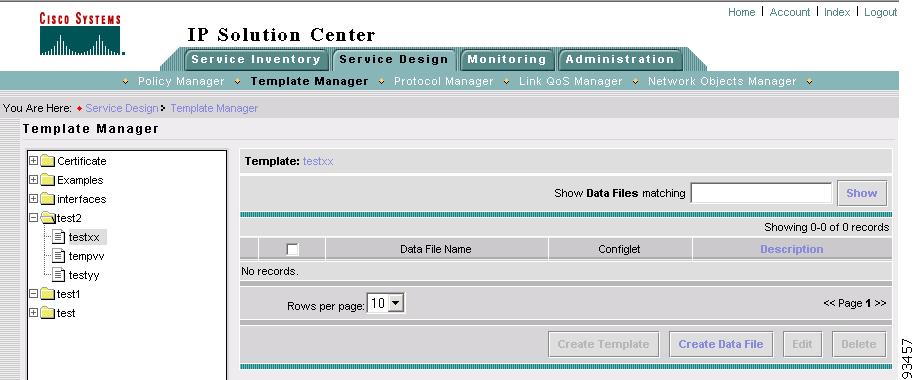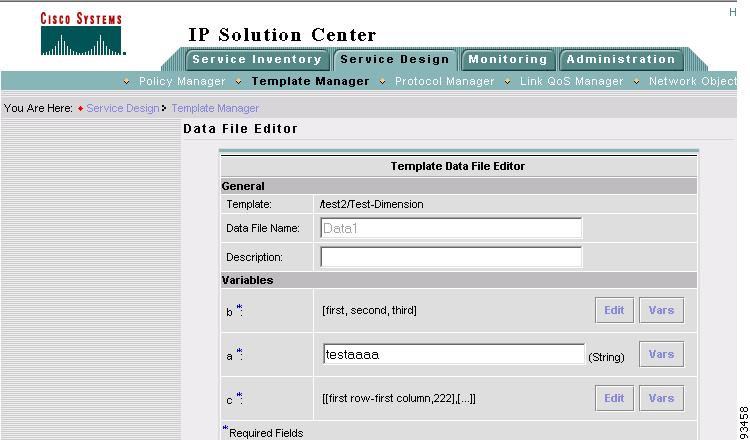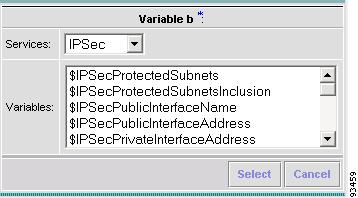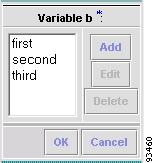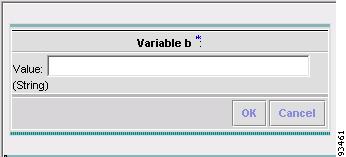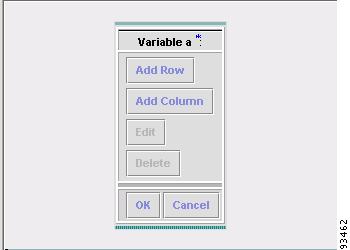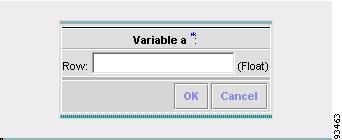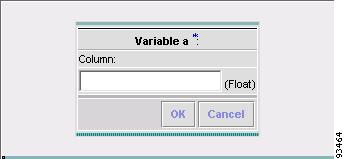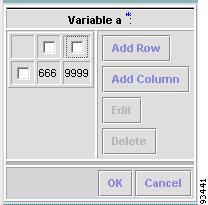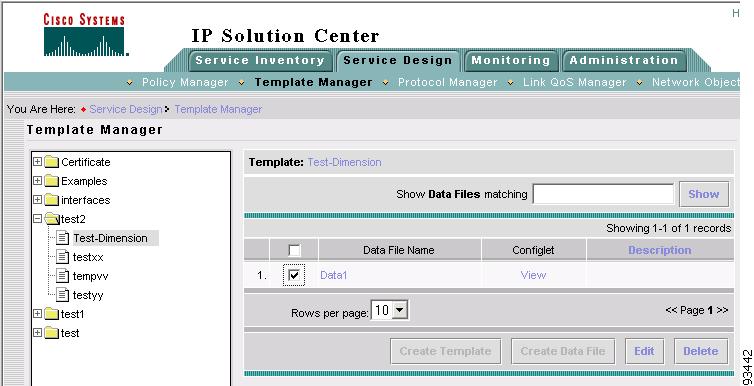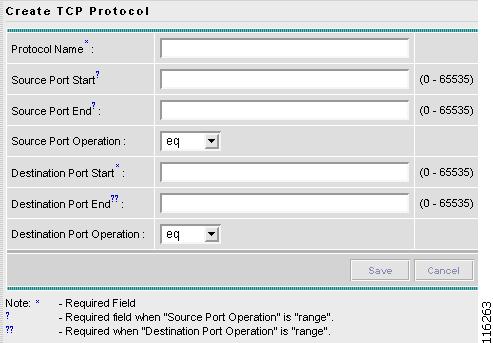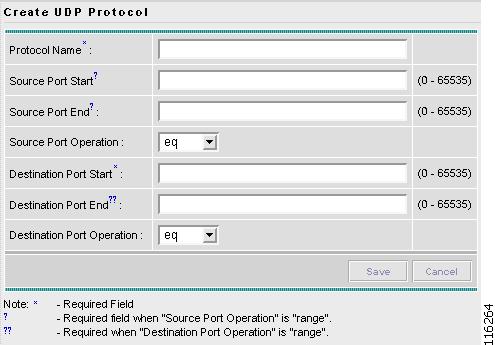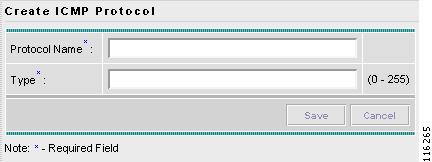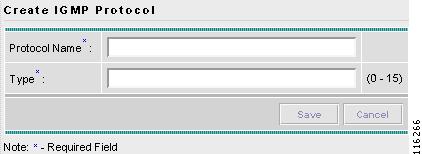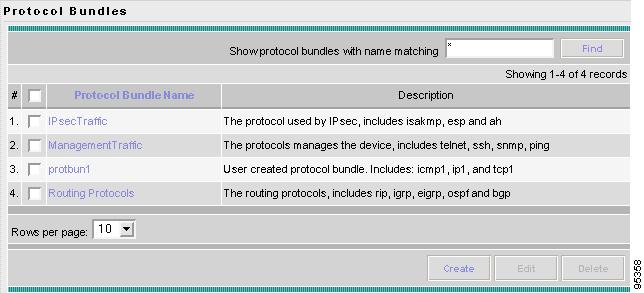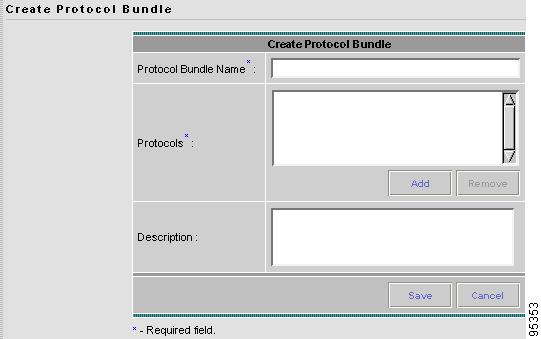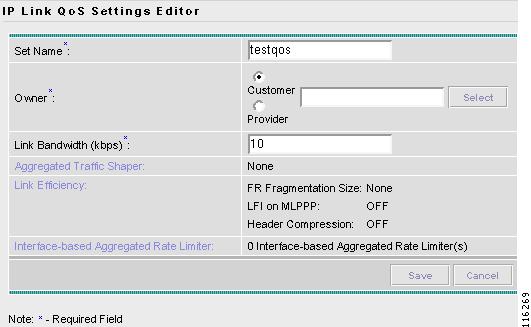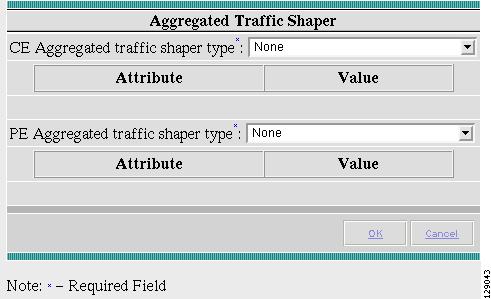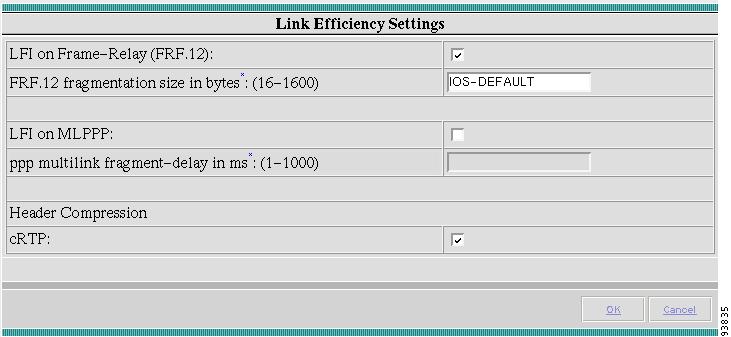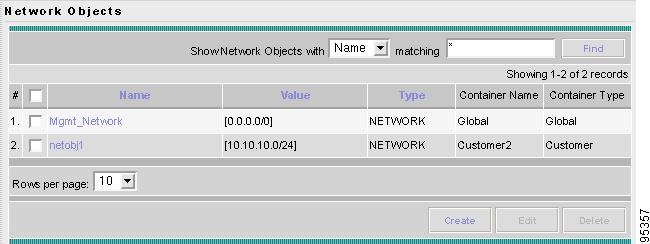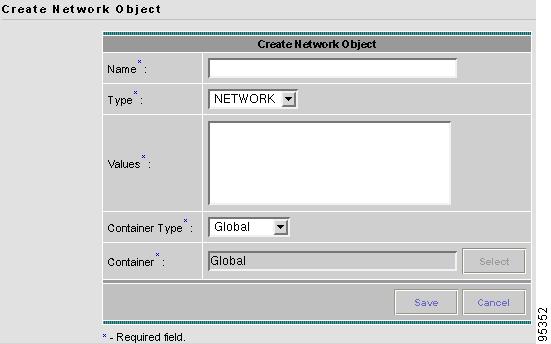

-
Cisco IP Solution Center Infrastructure Reference, 4.0
-
Index
-
About This Guide
-
Getting Started
-
WatchDog Commands
-
Service Inventory > Inventory and Connection Manager
-
Service Inventory > Inventory and Connection Manager > Inventory Manager
-
Service Inventory > Device Console
-
Service Design
-
Monitoring
-
Administration
-
Cisco CNS IE2100 Appliances
-
Property Settings
-
Glossary
-
Table Of Contents
View Templates Tree and Data Pane
Summary of Repository Variables
Service Design
From the Home window of Cisco IP Solution Center (ISC), you receive upon logging in, click the Service Design tab and you receive a window as shown in Figure 6-1, "Service Design Selections."
Figure 6-1 Service Design Selections
Next you can navigate to the following selections:
•
Policies Create and manage Policies for licensed services.
•
Templates Create and manage Templates and associated data.
•
Protocols Create and manage Protocols and Protocol Bundles.- This feature is NOT SUPPORTED in this release. -
•
Link QoS Create and manage IP Link QoS settings.
•
Network Objects Create and manage network objects for security services.- This feature is NOT SUPPORTED in this release. -
Policies
Policies is explained in each of the User Guides for each of the licensed services.
Templates
Templates supports the browsing, creation, and deletion of Template Folders, Templates, and Data Files as well as the viewing of Template-generated configurations. The configuration created from the template and data file can be downloaded to devices. When creating a Service Request, you can select from the list of templates and data files and associate them with the Service Request. At Deploy time, the template and data file are instantiated and the configuration is appended or prepended to the configlet generated by ISC.
ISC provides a way to integrate a template with ISC configlets.
For a given customer edge router, you specify the following:
•
template name
•
template data file name
•
whether the template configuration file should be appended or prepended to the ISC configlet
•
whether the template configuration file is active or inactive for downloading to the edge device
The template data files are tightly linked with the corresponding template. You can use a data file and its associated template to create a template configuration file. The template configuration file is merged with (either appended or prepended to) the ISC configlet. ISC downloads the combined ISC configlet and template configuration file to the edge device router.
•
You can download a template configuration file to a router.
•
You can apply the same template to multiple edge routers, assigning the appropriate template data file for each device. Each template data file includes the specific data for a particular device (for example, the management IP address or host name of each device).
To use Templates, do the following:
Step 1
Navigate to Service Design > Templates and you receive a window as shown in Figure 6-2, "Templates."
Figure 6-2 Templates
Template examples are shown in the left column. A complete list of template examples is specified in the "Template Examples" section. A complete list of Repository variables is shown in the "Summary of Repository Variables" section.
Step 2
Then you can do any of the following:
•
View Templates Tree and Data Pane
•
Create Folders and Subfolders
•
Edit
View Templates Tree and Data Pane
When you navigate to Service Design > Templates, you receive a window as shown in Figure 6-3, "Tree and Data Pane Structure."
The Templates tree is in the left column. You can continue clicking the + sign next to each created folder and subfolder until you get to the last level of information. The last possible level is the template name. Data file information is not kept in the tree.
The right section of the window is the data pane. The name of the folder or template is in the upper-left corner. When you select the check box next to the template or data file information, the Create Template, Create Data File, Edit, or Delete buttons are enabled as described in the following sections.
When there are many templates in a folder or many data files in a template, the Show Template Matching or Show Data File Matching filter in the upper right hand corner of the data pane can be very useful. For example, you might just want to work with templates or data files that start with abc. In this case, enter abc* in the field and then click the Show button. Only the templates or data files that start with abc appear.
You can also View configurations when the table displays data files.
Figure 6-3 Tree and Data Pane Structure
Create Folders and Subfolders
To create a new folder or subfolder, do the following:
Step 1
Navigate to Service Design > Templates.
Step 2
In the Templates tree, right-click in the white area and select New > Folder to create a new folder or right-click on an existing folder or subfolder and select New > Folder to create a subfolder.
Note
There is no limit to the number of levels of folders and subfolders you can create.
Step 3
In the new text field that appears in the Templates tree, type the new folder or subfolder name, as shown in the first entry of the Templates tree in Figure 6-4, "Folder Naming."
Figure 6-4 Folder Naming
Copying Folders or Subfolders
You can copy a folder or subfolder and paste it into another folder or subfolder, as follows:
Step 1
Select a folder or subfolder and then right-click and you receive the opportunity to copy. Click Copy.
Step 2
Select the folder or subfolder into which you want to paste the copied folder or subfolder and all its content. Right-click and you receive the opportunity to paste. Click Paste.
Step 3
You will see the new folder or subfolder and all its content in the selected location. You can edit and rename from there.
Create Template
You can either create a new template in an existing folder or you can create a new folder first and then create the template. To create a new folder, see the section "Create Folders and Subfolders".
To create a new template, do the following:
Step 1
Navigate to Service Design > Templates.
Step 2
In the Templates tree, click on the folder in which you want to create a new template.
Step 3
A window appears as shown in Figure 6-5, "Folder with Existing Templates."
Figure 6-5 Folder with Existing Templates
Step 4
Click the Create Template button and you receive a window as shown in Figure 6-6, "Template Editor."
Figure 6-6 Template Editor
Step 5
Enter the following:
•
Template Name (required) This must be a unique name within a folder. This name must begin with an alphabetic character and can only contain alphanumeric characters, underscores, and hyphens.
•
Description (optional) You can enter any description here.
•
Body (required) Enter the configuration text, Velocity template language directives, and variables that you want included.
Note
The Velocity template language is explained at http://jakarta.apache.org/velocity/user-guide.html.
An example template is shown in Figure 6-7, "Example Template."
Figure 6-7 Example Template
ISC has the template system predefined variable $TMSystem that can be used within the template body text to access template system functions. The syntax is as follows, where, $ipAddrMask is a string that contains an IP address and its mask in the format of: 10.33.4.5/30:
$TMSystem.getAddr ($ipAddrMask) returns: 10.33.4.5
$TMSystem.getMask ($ipAddrMask) returns: 255.255.255.252
$TMSystem.getReverseMask ($ipAddrMask) returns: 0.0.0.3
$TMSystem.getNetworkAddr ($ipAddrMask) returns: 10.33.4.4
$TMSystem.getClassfulNetworkAddr ($ipAddrMask) returns: 10.0.0.0
Step 6
Click the Select & Click Go drop-down button. If you want to validate the information you entered in Step 5, select Validate and then click the Go button. Otherwise, select Variables and then click the Go button and you receive a window as in Figure 6-8, Template Variables".
Figure 6-8 Template Variables
Step 7
Click the radio button for the Variable you want to edit and click Edit. You receive a window as in Figure 6-9, "Variable Definition—Type String."
Figure 6-9 Variable Definition—Type String
Step 8
In Figure 6-9, click the drop-down menu for Type to receive the following choices:
•
String Proceed to Step 9.
•
Integer Proceed to Step 10.
•
Float Proceed to Step 11.
•
IPv4 Address Proceed to Step 12.
•
Sub-Template Proceed to Step 13.
•
Dynamic Java Class Proceed to Step 14.
•
Dynamic URL Proceed to Step 15.
Step 9
The default Type to appear is String, a combination of ASCII characters considered as a group. The resulting Variable window is shown in Figure 6-9 and its attributes are as follows:
•
Description (optional) You can enter any descriptive statement about this variable here.
•
Required Leave the default of the selected check box if this variable is required. Otherwise, deselect it.
•
Dimension Choose 0 (default), which indicates a scalar or enum variable; choose 1, in which case the variable becomes a one-dimensional array; or choose 2, in which case the variable becomes a two-dimensional array.
•
Default (optional) If there is a default value for the specified variable, specify it here. If you also have Available Values defined, this default value must be an Available Value.
•
Pattern (optional) Specify a regular expression pattern of the string. For example, a pattern of isc[0-9]+ defines a string that starts with isc followed by one or more digits from 0 to 9.
•
Minimum Length (optional) If you specify a minimum length, the string cannot be less than the length specified here.
•
Maximum Length (optional) If you specify a maximum length, the string cannot exceed the length specified here.
•
Available Values (optional) Enter string values for this variable. Separate the values by commas.
After you enter all the data, click OK to accept this information for the specified variable; continue editing all variables you want to change in this same way, then click OK in a window such as Figure 6-8, which now includes these updated variables; click Save and then Close or click Close and when asked, agree to Save for a window such as Figure 6-6. Create a Data File is shown in the "Create Data File" section, Edit is shown in the "Edit" section, and Delete is shown in the "Delete" section.
Step 10
When you choose the Type Integer, a whole number, the resulting Variable window is shown in Figure 6-10 and its attributes are as follows:
•
Description (optional) You can enter any descriptive statement about this variable here.
•
Required Leave the default of the selected check box if this variable is required. Otherwise, deselect it.
•
Dimension Choose 0 (default), which indicates a scalar or enum variable; choose 1, in which case the variable becomes a one-dimensional array; or choose 2, in which case the variable becomes a two-dimensional array.
•
Default (optional) If there is a default value for the specified variable, specify it here. If you also have Available Values defined, this default value must be an Available Value.
•
Minimum Value (optional) If you specify a minimum value, the integer cannot be less than the value specified here.
•
Maximum Value (optional) If you specify a maximum value, the integer cannot exceed the value specified here.
•
Available Values (optional) Enter integer values for this variable. Separate the values by commas.
After you enter all the data, click OK to accept this information for the specified variable; continue editing all variables you want to change in this same way, then click OK in a window such as Figure 6-8, which now includes these updated variables; click Save and then Close or click Close and when asked, agree to Save for a window such as Figure 6-6. Create a Data File is shown in the "Create Data File" section, Edit is shown in the "Edit" section, and Delete is shown in the "Delete" section.
Figure 6-10 Variable Definition—Type Integer
Step 11
When you choose the Type Float, a number that has no fixed number of digits before or after the decimal point, the resulting Variable window is shown in Figure 6-11 and its attributes are as follows:
•
Description (optional) You can enter any descriptive statement about this variable here.
•
Required Leave the default of the selected check box if this variable is required. Otherwise, deselect it.
•
Dimension Choose 0 (default), which indicates a scalar or enum variable; choose 1, in which case the variable becomes a one-dimensional array; or choose 2, in which case the variable becomes a two-dimensional array.
•
Default (optional) If there is a default value for the specified variable, specify it here. If you also have Available Values defined, this default value must be an Available Value.
•
Minimum Value (optional) If you specify a minimum value, the floating point value cannot be less than the value specified here.
•
Maximum Value (optional) If you specify a maximum value, the floating point value cannot exceed the value specified here.
•
Available Values (optional) Enter floating point values for this variable. Separate the values by commas.
After you enter all the data, click OK to accept this information for the specified variable; continue editing all variables you want to change in this same way, then click OK in a window such as Figure 6-8, which now includes these updated variables; click Save and then Close or click Close and when asked, agree to Save for a window such as Figure 6-6. Create a Data File is shown in the "Create Data File" section, Edit is shown in the "Edit" section, and Delete is shown in the "Delete" section.
Figure 6-11 Variable Definition—Type Float
Step 12
When you choose the Type IPv4, the resulting Variable window is shown in Figure 6-12 and its attributes are as follows:
•
Description (optional) You can enter any descriptive statement about this variable here.
•
Required Leave the default of the selected check box if this variable is required. Otherwise, deselect it.
•
Dimension Choose 0 (default), which indicates a scalar or enum variable; choose 1, in which case the variable becomes a one-dimensional array; or choose 2, in which case the variable becomes a two-dimensional array.
•
Default (optional) If there is a default value for the specified variable, specify it here. If you also have Available Values defined, this default value must be an Available Value.
•
Subnet Mask (optional) Enter a valid subnet mask.
•
Class (optional) Enter the class of the IP address. The options are: A, B, or C.
•
Available Values (optional) Enter IPv4 values for this variable. Separate the values by commas.
After you enter all the data, click OK to accept this information for the specified variable; continue editing all variables you want to change in this same way, then click OK in a window such as Figure 6-8, which now includes these updated variables; click Save and then Close or click Close and when asked, agree to Save for a window such as Figure 6-6. Create a Data File is shown in the "Create Data File" section, Edit is shown in the "Edit" section, and Delete is shown in the "Delete" section.
Figure 6-12 Variable Definition—Type IPv4
Step 13
When you choose the Type Sub-Template, you instantiate one subtemplate into the Main template. The resulting Variable window is shown in Figure 6-13 and its attributes are as follows:
•
Description (optional) You can enter any descriptive statement about this variable here.
•
Required Leave the default of the selected check box if this variable is required. Otherwise, deselect it.
•
Location (required) Enter the full path name of the parent template. For example /test2/testyy.
The variable varName is defined as the subtemplate type (by selecting Variables and clicking Go). The Sub-Template defined earlier is called and you must provide the subtemplate path. The syntax is as follows:
$<varName>.callWithDatafile (<DatafileName>)
After you enter all the data, click OK to accept this information for the specified variable; continue editing all variables you want to change in this same way, then click OK in a window such as Figure 6-8, which now includes these updated variables; click Save and then Close or click Close and when asked, agree to Save for a window such as Figure 6-6. Create a Data File is shown in the "Create Data File" section, Edit is shown in the "Edit" section, and Delete is shown in the "Delete" section.
Figure 6-13 Variable Definition—Type Sub-Template
Step 14
When you choose the Type Dynamic Java Class, the resulting Variable window is shown in Figure 6-14 and its attributes are as follows:
•
Description (optional) You can enter any descriptive statement about this variable here.
•
Required Leave the default of the selected check box if this variable is required. Otherwise, deselect it.
The variable varName is defined as the Dynamic Java Class type (by selecting Variables and clicking Go). The syntax is as follows:
$<varName>.<method_name_in_Java_class> ([<parameters>])
After you enter all the data, click OK to accept this information for the specified variable; continue editing all variables you want to change in this same way, then click OK in a window such as Figure 6-8, which now includes these updated variables; click Save and then Close or click Close and when asked, agree to Save for a window such as Figure 6-6. Create a Data File is shown in the "Create Data File" section, Edit is shown in the "Edit" section, and Delete is shown in the "Delete" section.
Figure 6-14 Variable Definition—Type Dynamic Java Class
Step 15
When you choose the Type Dynamic URL, the resulting Variable window is shown in Figure 6-15 and its attributes are as follows:
•
Description (optional) You can enter any descriptive statement about this variable here.
•
Required Leave the default of the selected check box if this variable is required. Otherwise, deselect it.
The variable varName is defined as the Dynamic URL type (by selecting Variables and clicking Go). The syntax is as follows:
$<varName>.callURL (<url-address>)
After you enter all the data, click OK to accept this information for the specified variable; continue editing all variables you want to change in this same way, then click OK in a window such as Figure 6-8, which now includes these updated variables; click Save and then Close or click Close and when asked, agree to Save for a window such as Figure 6-6. Create a Data File is shown in the "Create Data File" section, Edit is shown in the "Edit" section, and Delete is shown in the "Delete" section.
Figure 6-15 Variable Definition—Type Dynamic URL
Copying Templates
You can copy a template and paste it into another folder, as follows:
Step 1
Select a template and then right-click and you receive the opportunity to copy. Click Copy.
Step 2
Select the folder into which you want to paste the copied template and all its data files. Right-click and you receive the opportunity to paste. Click Paste.
Step 3
You will see the new template and all its data files in the selected location. You can edit and rename from there.
Create Data File
You can create a new data file from an existing template. If the template you want is not available, go to the "Create Template" section.
To create a data file, do the following:
Step 1
Navigate to Service Design > Templates.
Step 2
In the Templates tree in the left part of your window, do one of the following
1.
Left-click on the folder or subfolder in which the template for which you want to create a data file exists or
2.
Click on the + next to the folder of choice and then click on the template for which you want to create a data file.
Step 3
If you chose 1. in Step 2, a window appears as shown in Figure 6-16, "Choose Existing Template > Create Data File."
Figure 6-16 Choose Existing Template > Create Data File
Select the check box for the template for which you want to create a data file and click Create Data File. Then proceed to Step 5.
Otherwise, proceed to Step 4.
Step 4
If you chose 2. in Step 2, the buttons appear as shown in Figure 6-17, "Choose Existing Template > Create Data File."
Figure 6-17 Choose Existing Template > Create Data File
Click Create Data File and proceed to Step 5.
Step 5
An example of a window that appears is shown in Figure 6-18, "Template Data File Editor."
Figure 6-18 Template Data File Editor
Step 6
In the General area, fill in the following:
•
Data File Name (required) This must be a unique name. This name must begin with an alphabetic character and can only contain alphanumeric characters and the underscore.
•
Description (optional) Enter any description that helps you identify this data file.
Step 7
In the example in Figure 6-18, in the Variables area, a is a string variable (Dimension defined when the template was created was 0); b is a one-dimensional array (Dimension defined when the template was created was 1); and c is a two-dimensional array (Dimension defined when the template was created was 1).
If a is a Dynamic Java Class variable, you must enter the entire Java Class package name. For example: com.cisco.isc.class_name.
Step 8
If you click Vars as shown in Figure 6-18, you receive a window as shown in Figure 6-19, "Template Data File Editor."
Figure 6-19 Template Data File Editor
Click the Services drop-down menu to have access to variables for:
•
IPsec - NOT SUPPORTED in this release. -
•
IPsecRA (IPsec Remote Access) - NOT SUPPORTED in this release. -
•
NAT - NOT SUPPORTED in this release. -
•
MPLS
•
L2VPN
Then click the entry in Variables that you want to use and click Select.
If you have a 0 dimensional entry (set as Dimension 0 when creating a template), you can only enter variables in the provided field.
Step 9
When you click Edit., as shown in Figure 6-18, the resulting window depends on whether you are editing a 1 or 2 dimensional array.
Proceed to Step 10 for information about a 1 dimensional array.
Proceed to Step 13 for information about a 2 dimensional array.
Step 10
For a one-dimensional array (set as Dimension 1 when creating the template), when you click Edit, you receive a window as shown in Figure 6-20, "Editing a One-Dimensional Array."
Figure 6-20 Editing a One-Dimensional Array
Step 11
To add a variable, click Add and a window, as shown in Figure 6-21, "Adding a Variable," appears in which you can add the variable. Then click OK.
Figure 6-21 Adding a Variable
Step 12
To edit or delete a variable, highlight the variable in Figure 6-20 and click Edit or Delete. For Edit you receive a figure as in Figure 6-21. Then click OK. For Delete, be sure you want to delete. After you click Delete, it automatically occurs and the window is updated. Proceed to Step 19.
Step 13
For a two-dimensional array (set as Dimension 2 when creating the template), when you click Edit, you receive a window as shown in Figure 6-22, "Editing a Two-Dimensional Array.
Figure 6-22 Editing a Two-Dimensional Array
Step 14
Click Add Row in Figure 6-22 and a window, as shown in Figure 6-23, "Enter Row Information," appears. Enter a value and click OK.
Figure 6-23 Enter Row Information
Step 15
Click Add Column in Figure 6-22 and a window as shown in Figure 6-24, "Enter Column Information," appears. Enter a value and click OK.
Figure 6-24 Enter Column Information
Step 16
A resulting window, as shown in Figure 6-25, "Two-Dimensional Array Results," appears.
Figure 6-25 Two-Dimensional Array Results
Step 17
You can select any of the check boxes (toggles) and you can then Edit or Delete that row or column. You can also continue to Add Row and Add Column as shown in Step 15 and Step 16, respectively.
Step 18
When you complete setting up your two-dimensional array, click OK in Figure 6-25.
Step 19
A window as shown in Figure 6-18 is updated to reflect the new data file information.
Step 20
You can then click Save and then Close to save this information and close this file; click Configure to show the configuration file; or click Close and then be sure to click OK, if you want to save the information you have created. If you do not want to save this information, click Close and then click Cancel.
Edit
To edit a Template or Data File, do the following:
Step 1
Navigate to Service Design > Templates.
Step 2
In the Templates tree, left-click on the folder or subfolder in which the template you want to edit exists or the template in which the data file you want to edit exists. Alternatively, when the name in the upper left corner of the data pane is a template, you can click on the template name to edit the template.
Step 3
To edit a template, a window appears as shown in Figure 6-26, "Choose Existing Template > Edit." To edit a data file, a window appears as shown in Figure 6-27, "Choose Existing Data File > Edit."
Figure 6-26 Choose Existing Template > Edit
Figure 6-27 Choose Existing Data File > Edit
Step 4
Select the check box for the template or data file you want to edit.
Note
For a data file, there is a Configlet column in which you can click View to view the configuration file.
Step 5
Click Edit.
Step 6
When editing a template, you receive a window as shown in Figure 6-6, "Template Editor." Then proceed as in in the "Create Template" section. When editing a data file, you receive a window as shown in Figure 6-17, "Choose Existing Template > Create Data File." Then proceed as in Step 5 in the "Create Data File" section.
Delete
To delete a Template or Data File, do the following:
Step 1
Navigate to Service Design > Templates.
Step 2
In the Templates tree, left-click on the folder or subfolder in which the template you want to delete exists or the template in which the data file you want to delete exists.
Step 3
To delete a template, a window appears as shown in Figure 6-28, "Choose Existing Template > Delete." To delete a data file, a window appears as shown in Figure 6-29, "Choose Existing Data File > Delete."
Figure 6-28 Choose Existing Template > Delete
Figure 6-29 Choose Existing Data File > Delete
Step 4
Select the check box for the template or data file you want to delete.
Note
For a data file, there is a Configlet column in which you can click View to view the configuration file.
Step 5
Click Delete.
Step 6
You receive an updated window as shown in Figure 6-28, "Choose Existing Template > Delete" or Figure 6-29, "Choose Existing Data File > Delete" with the deleted template or data file no longer available.
Template Examples
In the left column, the hierarchy pane, of Service Design > Templates, as shown in Figure 6-2, "Templates," template examples appear. See Table 6-1, "Template Examples and Their Descriptions."
Summary of Repository Variables
This section contains the following tables:
•
Table 6-2, "IPsec Remote Access Repository Variables - NOT SUPPORTED in this release. -"
•
Table 6-3, "IPsec Site-to-Site Repository Variables - NOT SUPPORTED in this release. -"
•
Table 6-4, "L2VPN Repository Variables"
•
Table 6-5, "MPLS Repository Variables"
•
Table 6-6, "NAT Repository Variables - NOT SUPPORTED in this release. -"
•
Table 6-7, "QoS Repository Variables"
•
Table 6-8, "VPLS Repository Variables"
Table 6-2 provides a summary of the IPsec Remote Access Repository variables available from ISC Templates.- NOT SUPPORTED in this release. -
Table 6-3 provides a summary of the IPsec Site-to-Site Repository variables available from ISC Templates. - NOT SUPPORTED in this release. -
Table 6-4 provides a summary of the L2VPN Repository variables available from ISC Templates.
Table 6-5 provides a summary of the MPLS Repository variables available from ISC Templates.
Table 6-6 provides a summary of the NAT Repository variables available from ISC Templates. - NOT SUPPORTED in this release. -
Table 6-7 provides a summary of the QoS Repository variables available from ISC Templates.
Table 6-8 provides a summary of the VPLS Repository variables available from ISC Templates.
Protocols
- This feature is NOT SUPPORTED in this release. -
Protocols allows you to define customized protocol(s) that are not predefined. ISC defines most commonly used protocols. This Protocol Manager is used to customize protocol definition(s).The protocol is used by access rules in an ISC Firewall policy.
From Figure 6-1, navigate Service Design > Protocols and you can choose either of the following:
•
Protocols Create and manage protocols.
•
Protocol Bundles Create and manage protocol bundles.
Protocols
The Protocols feature allows you to create customized protocols for TCP, UDP, ICMP, IGMP, and IP protocols.
All the possible choices for Protocols can be handled as follows:
Step 1
Navigate Service Design > Protocols and then choose Protocols. A window such as Figure 6-30, "Protocols," appears.
Figure 6-30 Protocols
Proceed to one of the following:
•
Create TCP Make no selections. From the Create drop-down menu, click TCP.
•
Create UDP Make no selections. From the Create drop-down menu, click UDP.
•
Create ICMP Make no selections. From the Create drop-down menu, click ICMP.
•
Create IGMP Make no selections. From the Create drop-down menu, click IGMP.
•
Create IP Make no selections. From the Create drop-down menu, click IP.
•
Edit Select one check box to select one protocol, and then click Edit to modify it.
•
Delete Select one or more check boxes to select one or more protocols, and then click Delete to delete the chosen protocols (you can select all the listed protocols by selecting the check box in the header row).
Create TCP
To create a TCP protocol, navigate Service Design > Protocols, choose Protocols, and follow these steps:
Step 1
Click the Create button and from the drop-down menu, click TCP.
Step 2
A window as shown in Figure 6-31, "Create TCP Protocol," appears.
Figure 6-31 Create TCP Protocol
Enter the following fields:
•
Protocol Name (required)
•
Source Port Start (optional) If the Source Port Operation is range, this field is required. Specify the Source Port Start (0-65535).
•
Source Port End (optional If the Source Port Operation is range, this field is required. Specify the Source Port End (0-65535).
•
Source Port Operation (optional) The drop-down menu choices are eq for equal; gt for greater than; lt for less than; neq for not equal; and range for a range of values. The check is for the port number and these qualifiers are for that port. For example, checking only for a port number equal (eq) to the port number specified, checking only for port numbers greater than (gt) the port specified, and so on.
•
Destination Port Start (required) Specify the Destination Port Start (0-65535).
•
Destination Port End (optional) If the Destination Port Operation is range, this field is required. Specify the Destination Port End (0-65535).
•
Destination Port Operation (required when Source Port Start is specified) The drop-down menu choices are eq for equal; gt for greater than; lt for less than; neq for not equal; and range for a range of values. The check is for the port number and these qualifiers are for that port. For example, checking only for a port number equal (eq) to the port number specified, checking only for port numbers greater than (gt) the port specified, and so on.
Click Save.
Step 3
You return to an updated Figure 6-30 and a Status block with a green check mark for Succeeded.
Create UDP
To create a UDP protocol, navigate Service Design > Protocols, choose Protocols, and follow these steps:
Step 1
Click the Create button and from the drop-down menu, click UDP.
Step 2
A window as shown in Figure 6-32, "Create UDP Protocol," appears.
Figure 6-32 Create UDP Protocol
Enter the following fields:
•
Protocol Name (required)
•
Source Port Start (optional) If the Source Port Operation is range, this field is required. Specify the Source Port Start (0-65535).
•
Source Port End (optional If the Source Port Operation is range, this field is required. Specify the Source Port End (0-65535).
•
Source Port Operation (required) The drop-down menu choices are eq for equal; gt for greater than; lt for less than; neq for not equal; and range for a range of values. The check is for the port number and these qualifiers are for that port. For example, checking only for a port number equal (eq) to the port number specified, checking only for port numbers greater than (gt) the port specified, and so on.
•
Destination Port Start (required) Specify the Destination Port Start (0-65535).
•
Destination Port End (optional) If the Destination Port Operation is range, this field is required. Specify the Destination Port End (0-65535).
•
Destination Port Operation (required when Source Port Start is specified) The drop-down menu choices are eq for equal; gt for greater than; lt for less than; neq for not equal; and range for a range of values. The check is for the port number and these qualifiers are for that port. For example, checking only for a port number equal (eq) to the port number specified, checking only for port numbers greater than (gt) the port specified, and so on.
Click Save.
Step 3
You return to an updated Figure 6-30 and a Status block with a green check mark for Succeeded.
Create ICMP
To create an ICMP protocol, navigate Service Design > Protocols, choose Protocols, and follow these steps:
Step 1
Click the Create button and from the drop-down menu, click ICMP.
Step 2
A window as shown in Figure 6-33, "Create ICMP Protocol," appears.
Figure 6-33 Create ICMP Protocol
Enter the following fields:
•
Protocol Name (required)
•
Type (required) This must be a valid ICMP type (0-255).
Step 3
Click Save.
Step 4
You return to an updated Figure 6-30 and a Status block with a green check mark for Succeeded.
Create IGMP
To create an IGMP protocol, navigate Service Design > Protocols, choose Protocols, and follow these steps:
Step 1
Click the Create button and from the drop-down menu, click IGMP.
Step 2
A window as shown in Figure 6-34, "Create IGMP Protocol," appears.
Figure 6-34 Create IGMP Protocol
Enter the following fields:
•
Protocol Name (required)
•
Type (required) This must be a valid IGMP type (0-15).
Step 3
Click Save.
Step 4
You return to an updated Figure 6-30 and a Status block with a green check mark for Succeeded.
Create IP
To create an IP protocol, navigate Service Design > Protocols, choose Protocols, and follow these steps:
Step 1
Click the Create button and from the drop-down menu, click IP.
Step 2
A window as shown in Figure 6-35, "Create IP Protocol," appears.
Figure 6-35 Create IP Protocol
Enter the following fields:
•
Protocol Name (required)
•
Protocol Number (required) For example, for the GRE protocol, the protocol number is 47 (0-255).
Step 3
Click Save.
Step 4
You return to an updated Figure 6-30 and a Status block with a green check mark for Succeeded.
Edit
From Figure 6-30, do the following to edit a protocol:
Step 1
Select one check box, thus selecting only one protocol.
Click the Edit button and a window as shown in the create section for this protocol type appears, except that this is an Edit window and the Name cannot be changed. Complete the remaining fields as explained in the Create sections. And then click Save.
Step 2
Figure 6-30 appears with the updated information.
Delete
From Figure 6-30, do the following to delete protocols:
Step 1
Select one or more check boxes (to choose all the listed protocols, select the check box in the header row), thus selecting protocol(s).
Click the Delete button and a Confirm Delete window gives you the opportunity to continue, by clicking Delete or cancel the delete process by clicking Cancel.
Step 2
Figure 6-30 appears with the updated information.
Protocol Bundles
Protocol Bundles allows you to group Protocols and to use them as a single entity.
All the possible choices for Protocols Bundles can be handled as follows:
Step 1
Navigate Service Design > Protocols and then choose Protocol Bundles. A window such as Figure 6-36, "Protocols Bundles," appears.
Figure 6-36 Protocols Bundles
Proceed to one of the following:
•
Create Protocol Bundles Make no selection. Click Create.
•
Edit Select one check box to select one protocol bundle, and then click Edit to modify it.
•
Delete Select one or more check boxes to select one or more protocol bundles, and then click Delete to delete the chosen protocol bundles (you can select all the listed protocol bundles by selecting the check box in the header row).
Create Protocol Bundles
Navigate Service Design > Protocols, choose Protocol Bundles, and follow these steps:
Step 1
Click the Create button.
Step 2
A window as shown in Figure 6-37, "Create Protocol Bundles," appears.
Figure 6-37 Create Protocol Bundles
Enter the following fields:
•
Protocol Bundle Name (required)
•
Protocols (required) Click Add and a list of protocols appears. Select one or more protocols for this protocol bundle and then click Select. The protocols are listed. You can select highlight one or more protocols and then click Remove to remove these selections.
Description (optional) This information is for clarity of description of the protocol bundle.
Step 3
Click Save.
Step 4
You return to an updated Figure 6-36 and a Status block with a green check mark for Succeeded.
Edit Protocol Bundles
From Figure 6-36, do the following to edit a protocol bundle:
Step 1
Select one check box, thus selecting only one protocol bundle.
Click the Edit button and a window as shown in Figure 6-37 appears, except that this is an Edit Protocol Bundle window and the Name cannot be changed. Complete the remaining fields as explained in the "Create Protocol Bundles" section. And then click Save.
Step 2
Figure 6-36 appears with the updated information.
Delete Protocol Bundles
From Figure 6-36, do the following to delete protocol bundles:
Step 1
Select one or more check boxes (to choose all the listed protocol bundles, select the check box in the header row), thus selecting protocol bundle(s).
Click the Delete button and a Confirm Delete window gives you the opportunity to continue, by clicking Delete or cancel the delete process by clicking Cancel.
Step 2
Figure 6-36 appears with the updated information.
Link QoS
The Link QoS deals with link-level QoS settings such as Aggregate Shapers (FRTS; ATM Shapers, parent-level cb-shaper), Link Efficiency Mechanisms (FRF.12, LFIoMLPPP, and cRTP), and Interface-based CAR, those that depend on Layer2 encapsulation and link bandwidth.
You can create a link QoS setting for a network independent of a VPN service. To create a Link QoS setting for an MPLS service, see Cisco IP Solution Center Quality of Service User Guide, 4.0.
When you navigate Service Design > Link QoS, a window appears, as shown in Figure 6-38, "Link QoS Settings."
Figure 6-38 Link QoS Settings
The current Link QoS settings are available for QoS service requests, including the following information about each Link QoS setting:
•
Set Name the name of your link QoS settings
•
Owner Customer or Provider
•
Encapsulation
•
Bandwidth (in kbps) for IP Link QoS Setting
The explanation of the buttons and subsequent drop-down menus is given as follows:
•
Create This section explains how to create IP Link QoS Settings.
•
Copy This section explains how to copy an IP Link QoS Setting.
•
Edit This section explains how to edit an IP Link QoS Setting.
•
Delete This section explains how to delete an IP Link QoS Setting.
Create
When you navigate Service Design > Link QoS, click the Create button at the bottom of the window, as shown in Figure 6-38. To create IP Link QoS settings, proceed as follows:
Step 1
When you click the Create button, you receive a window as shown in Figure 6-39, "IP Link Settings Editor."
Figure 6-39 IP Link Settings Editor
Step 2
Fill in the following:
•
Set Name (required) The name of the link QoS settings. Specify a name that describes the service offered by the settings. Examples: Frame_64K_Gold; ATM_2Mb_Silver. The name Frame_64K_Gold indicates that this set should be used on a CPE-PE link of bandwidth 64kbps, whose layer-2 encapsulation is Frame Relay and to meet an SLA of Gold.
•
Owner (required) Keep the Customer radio button selected (default) or click the Provider radio button. Then click Select and you receive a list of the customers or providers, as applicable. You can filter this list. From the selected customers or providers, click the radio button for the customer or provider you want to select and click Select. You can repeat this procedure if you want to change your selection.
•
Link Bandwidth (required) The link bandwidth specifies the maximum amount of bandwidth allocated for packets belonging to this link.
•
Aggregated Traffic Shaper Applies traffic shaping QoS parameters to the device interface. Use this method instead of applying traffic shaping parameters with a service class. Click on the words Aggregated Traffic Shaper and you receive a window as shown in Figure 6-40, "Aggregated Traffic Shaper."
Figure 6-40 Aggregated Traffic Shaper
–
Click the drop-down menu for the CE and for the PE and select one of the following traffic shaper types. You receive another window in which to specify more information for Attribute and Value.
FR Traffic Shaper Frame Relay Traffic Shaper. Class-based Parent-level Shaper that operates only in distributed mode on VIP-based routers, such as the Cisco 7500 series platforms.
FR Traffic Shaper (non-MQC) Frame Relay Traffic Shaper. This shaper operates on 72xx and low-end routers.
Parent-level Class-based Shaper Used in the context of nested policy. A nested policy consists of a bottom-level policy that identifies one or more classes of traffic, and a top-level policy that shapes the output of the traffic classes into a single shape rate. You can apply a nested policy to an interface or subinterface.
ATM Traffic Shaper (VBR-rt) Variable bit rate-real time Intended for real-time applications, such as compressed voice over IP and video conferencing, that require tightly constrained delays (cell transfer delay or cell delay variation).
ATM Traffic Shaper (VBR-nrt) Variable bit rate-non real time Follows a leaky bucket or token bucket algorithm.
ATM Traffic Shaper (CBR) Constant bit rate Designed for ATM virtual circuits (VCs) that need a static amount of bandwidth that is continuously available for the duration of the active connection.
ATM Traffic Shaper (ABR) Configures a router to transmit at a rate that varies with the amount of bandwidth available in the network or along the end-to-end transmission path.
None
–
Click OK. The updated information appears in Figure 6-39.
•
Link Efficiency Based on the bandwidth of CPE-PE link. Link efficiency features work with queueing and traffic shaping to improve the efficiency and predictability of the application service levels. Click on the words Link Efficiency and you receive a window as shown in Figure 6-41, "Link Efficiency Settings."
Figure 6-41 Link Efficiency Settings
–
Select the check box for one of the following:
LFI on Frame Relay (FRF.12) (default) Supports the transport of real-time voice and data traffic on Frame Relay virtual circuits (VCs) without causing excessive delay to the real-time traffic. If you choose this, you can override the following field with a number (16 - 1600), which specifies the fragmentation size in bytes.
or
LFI on MLPP Multilink PPP (MLPPP) provides a method of splitting, recombining, and sequencing datagrams across multiple logical data links. MLPPP allows packets to be fragmented and the fragments to be sent at the same time over multiple point-to-point links to the same remote address.
–
Leave the cRTP check box for Header Compression selected (default) or deselect it. cRTP compresses the IP/UDP/RTP header in an RTP data packet from 40 bytes to approximately 2 to 5 bytes. Use cRTP on a WAN interface where bandwidth is an issue and much of the traffic is RTP traffic.
–
Click OK. The updated information appears in Figure 6-39.
•
Interface-based Aggregated Rate Limiter This provides rate limiting for the traffic on a particular interface for the CPE-PE link. Click on the words Interface-based Aggregated Rate Limiter and you receive a window as shown in Figure 6-42, "Interface-based Aggregated Rate Limiter List."
Figure 6-42 Interface-based Aggregated Rate Limiter List
–
Add is available when no choice is made. Click Add and you receive a window that lets you enter the following information. Then click OK to return to Figure 6-42 with updated information.
Traffic Classification (required) Specifies the method for classifying traffic. Click Edit to access the Traffic Classification Editor and choose from these selections.
Direction (required) Click the drop-down menu and choose OUTPUT (default) or INPUT. This specifies the direction of traffic to apply rate limiting parameters to.
Mean Rate in bps: (8000 - 2000000000) (required).
Conformed burst size in bytes: (1000 - 512000000) (required).
Extended burst size in bytes: (2000 - 1024000000) (required).
Conform—Action (required) Click the drop-down menu and choose: Transmit, which sends the packet; Drop, which drops the packet; Set-dscp-transmit, which sets the DSCP value and transmits the packet (must additionally specify a DSCP value in the drop-down menu); Set-prec-transmit, which sets the IP Precedence (0 to 7) values and sends the packet (must additionally specify an IP Precedence value in the drop-down menu); Set-mpls-exp-transmit, which sets the mpls experimental (0 to 7) values and sends the packet (must additionally specify an mpls experimental value in the drop-down menu); Set-dscp-continue, which sets the DSCP value and transmits the packet (must additionally specify a DSCP value in the drop-down menu); Set-prec-continue, which sets the IP Precedence (0 to 7) values and sends the packet (must additionally specify an IP Precedence value in the drop-down menu); or Set-mpls-exp-continue, which sets the mpls experimental (0 to 7) values and sends the packet (must additionally specify an mpls experimental value in the drop-down menu).
Exceed—Action (required) Click the drop-down menu and use the same choices as in Conform—Action to specify how to handle packets that exceed the configured rate limit.
–
Edit is available when one check box is selected. You can edit the information that is specified for Add. Click Edit. After you make your edits, click OK.
–
Delete is available when one or more check boxes are selected. Click Delete. The selection is deleted without confirmation.
Note
Be careful that you are sure you want to delete before clicking Delete. The deletion occurs automatically without confirmation.
–
OK returns you to Figure 6-39.
–
Cancel is available to cancel this process.
Step 3
After making all the selections in Step 2, click Save in Figure 6-39.
Step 4
Figure 6-38 reappears with the new IP Link QoS Setting and a Status box in the lower left corner with a green check mark for Succeeded.
Copy
The Copy button at the bottom of Figure 6-38, allows you to create a copy of a Link QoS and then make changes and save it with a new name.
Edit
The Edit button, at the bottom of Figure 6-38, allows you to edit a specific link QoS setting. Follow these steps:
Step 1
Navigate Service Design > Link QoS Settings.
Step 2
Select the check box for the row of the link QoS setting that you want to edit.
Step 3
Click the Edit button and a window appears as in Figure 6-39. Edit, following the windows in Create.
The Owner cannot be changed.
Step 4
Click Save and Figure 6-38 reappears with the new Link QoS Setting and a Status box in the lower left corner with a green check mark for Succeeded.
Delete
The Delete button, at the bottom of Figure 6-38, allows you to delete one or more link QoS settings. Follow these steps:
Step 1
Navigate Service Design > Link QoS Settings.
Step 2
Select the check box(es) for the row(s) of the link QoS setting(s) you want to delete or select the check box in the header row to select all the link QoS settings for deletion.
Step 3
Click the Delete button and the selected link QoS settings are deleted without a chance to confirm. Otherwise click Cancel.
Note
You receive no opportunity to confirm what you want to delete, so be sure you want to delete what you have selected.
Network Objects
- This feature is NOT SUPPORTED in this release. -
Network Objects allows you to create network objects. When you define a network object, you can use this object in a QoS policy or Firewall policy- Firewall policy is NOT SUPPORTED in this release. - rather than using the actual address itself. This simplifies Firewall policy- Firewall policy NOT SUPPORTED in this release. - or QoS policy creation.
From Figure 6-1, navigate Service Design > Network Objects and follow these steps:
Step 1
The first window to appear is as shown in Figure 6-43, "Network Objects."
Figure 6-43 Network Objects
Step 2
From this window, you can do any of the following:
•
Create Network Objects This is enabled when no network objects are selected.
•
Edit Network Objects This is enabled when only one network object is selected.
•
Delete Network Objects This is enabled when one or more network objects are selected.
Create Network Objects
From Figure 6-43, do the following to create a network object:
Step 1
Select no check box, thus selecting no network objects.
Step 2
Click the Create button and a window as shown in Figure 6-44, "Create Network Object," appears.
Figure 6-44 Create Network Object
Enter the following information:
•
Name (required)
•
Type (required) Click the drop-down menu and choose STRING (a free-style string object), NETWORK (a range of IP addresses), or HOST (a specific IP address).
•
Values (required) Enter a valid IP address in the format of a.b.c.d/e or a list of valid IP addresses in that format.
•
Container Type (required) Click the drop-down menu and choose Global, Customer, Site, or CPE.
•
Container (required) If you chose Customer (proceed to Step 3), Site, (proceed to Step 4), or CPE (proceed to Step 5) as the Container Type, then Select is enabled here. After you make your selection in the resulting window, click Select and you return to the updated Figure 6-44.
Step 3
If you set the Container Type to Customer, when you click Select for Container, a Customer for Container Selection window occurs, in which you can click one of the radio buttons and then click Select. This customer is added to your Container.
Step 4
If you set the Container Type to Site, when you click Select for Container, a Site for Container Selection window appears in which you can select one radio button for a site and then click Select. This site is added to your Container.
Step 5
If you set the Container Type to CPE, when you click Select for Container, a CPE for Container Selection window appears in which you can select one radio button for a CPE and then click Select. This CPE is added to your Container.
Step 6
Click Save in Figure 6-44 and you return to an updated Figure 6-43.
Edit Network Objects
From Figure 6-43, do the following to edit a network object:
Step 1
Select one check box, thus selecting only one network object.
Click the Edit button and a window as shown in Figure 6-44 appears, except that this is an Edit Network Object window and the Name cannot be changed. Complete the remaining fields as explained in the "Create Network Objects" section. And then click Save.
Step 2
Figure 6-43 appears with the updated information.
Delete Network Objects
From Figure 6-43, do the following to delete network objects:
Step 1
Select one or more check boxes (to choose all the listed network objects, select the check box in the header row), thus selecting network object(s).
Click the Delete button and a Confirm Delete window gives you the opportunity to continue, by clicking Delete or cancel the delete process by clicking Cancel.
Step 2
Figure 6-43 appears with the updated information.

 Feedback
Feedback